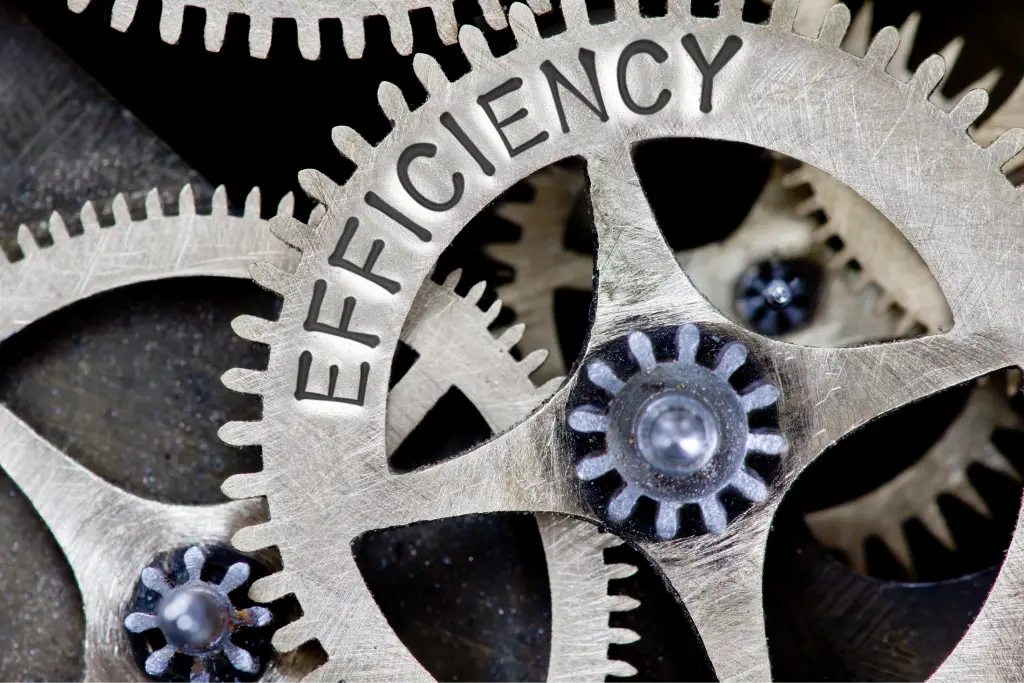Efficiency should always be at the forefront of any industry, but it is especially important for businesses involved in manufacturing. Those within the manufacturing realm are continuously searching for new methods to improve their efficiency and advance their standing in the market, which ultimately increases profits.
Many turn to manufacturing business consulting for expert guidance to identify bottlenecks and tweak current production processes. In this article, we will discuss strategies we’ve advised large enterprises and small businesses alike to improve manufacturing efficiency.
What Is Efficiency in Manufacturing?
An efficient manufacturing process comes down to economics. Simply put, it is the ability to produce goods and services with the least time, materials, and labor. In other words, it measures how well a company uses resources to create products.
While often used interchangeably with productivity, it is not the same thing. Manufacturing productivity focuses on increasing the number of products delivered. In contrast, manufacturing efficiency has to do with improving the effectiveness and quality of the work done.
Measuring manufacturing efficiency is necessary to determine profit potential and identify the need for more resources, whether machines or human capital.
The Importance of Improving Manufacturing Efficiency
When you improve production efficiency, you reap the following benefits:
- Enhanced Product Quality: Streamlining systems and processes reduces production line inconsistencies.
- Reduced Environmental Impact: Efficient manufacturing processes minimize resource consumption and lower environmental impacts.
- Lower Expenses: Production efficiency assessments unveil ways to streamline processes and reduce production costs without sacrificing quality.
- Greater Employee Engagement: Eliminating inefficiencies helps employees focus on tasks that provide genuine value, boosting morale and reducing staff turnover.
- Increased Competitive Advantage: Optimizing production processes allows businesses to effectively compete with their rivals. Often, they can deliver better quality products and services at a cost-effective rate, allowing them to outshine their fellow competitors in the industry.
- Improved Capabilities: By working efficiently, it is possible to meet customer demand without needing to increase personnel or resources.

Productivity vs. Efficiency in Manufacturing
As previously mentioned, productivity and efficiency are two distinct paths of optimization. Productivity is a measure of output compared to a measure of input. It anticipates economic growth and competitive success.
Efficiency refers to the quality of work done. It focuses on resource utilization in the most effective way possible. Setting efficiency goals helps manufacturers to work correctly, optimizing the use of resources while still delivering a high-quality product.
Balancing productivity and efficiency limits loss and risk while meeting demand levels and maintaining customer satisfaction. Without productivity and efficiency, manufacturing companies risk losing out on potential customers and associated revenue.
Leveraging Manufacturing Efficiency for Optimal Results
Comparing your company’s actual production to its expected production provides insight into the efficiency of the manufacturing process.
For example, suppose you expect to produce 20,000 units each week but only manage to make 15,000. In that case, you can calculate the discrepancy with the following formula: subtract the actual output (e.g., 15,000) from the standard output (e.g., 20,000) to determine the difference between the two.
This calculation yields a production differential that shows how efficiently your company produces goods.
Actual Output
Determine your company’s output by analyzing the cost of producing a set number of items. Let’s say you made 8,000 items, and the price was $20,000. The 8,000 units figure is the output. To calculate the actual output, divide the total cost by the number of items produced. This means that the actual output in this example is $2.50 per item.
Standard Output
You can calculate standard output by looking at current data and your expected performance of the machinery, team, and resources. You can also use a competitor’s successful output as a reference.
For instance, if a competitor outputs 800 units for $2,400, they produce each item for approximately $3. To gain insight into your production, determine the cost per unit for the same item.
Supposing it is about $4.50 due to your supplier’s pricier raw materials, this implies that your business is around 22.2% less efficient when producing the same product.

Common Manufacturing Efficiency KPIs
To ensure a manufacturing business is successful, it is important to track and measure the performance of key processes and operations. This can be done through the use of key performance indicators (KPIs).
Overall Equipment Effectiveness
The Overall Equipment Effectiveness (OEE) is a measure of efficiency that can be used to determine the amount of end product that an organization produces compared to the amount that could potentially be produced.
It considers key factors such as the availability of equipment, the performance rate of the equipment, and the quality of the end product to identify losses, compare results, and eliminate waste.
OEE can be calculated using the formula:
Availability x Performance Rate x Quality Rate = OEE
Material Yield
The material yield is the measure of the efficiency of converting raw materials into finished products.
To determine your total material yield, divide the expected number of materials used in the production process by the actual number of materials used to obtain the final yield.
This ratio can become more complex if multiple ingredients are used in the same product, but having an “ingredients list” available will make it simpler to figure out.
Labor Efficiency
Labor efficiency is the ratio of actual output to the maximum potential output given a certain workforce. It’s a helpful metric to track in the case that there is an insufficient supply of labor in production and you are looking to evaluate the effects of such a deficit.
To calculate labor efficiency, simply divide the actual output by the ideal output.
Please note this measure is only beneficial when labor shortages are the primary contributor to changes in output. In the event that other factors are the main cause of output alterations, using Overall Equipment Effectiveness (OEE) is more accurate.
Material Costs
The cost of materials affects production efficiency and profits. If fuel prices fluctuate, the supply of materials changes or you switch providers, the cost of materials can go up or down. For instance, if materials become more widely accessible, the price may decrease, resulting in a lower cost for you to produce each unit and a higher potential for profits.
Reducing expenses by reviewing material costs and looking for cheaper substitutes, assessing suppliers’ performance and reliability, negotiating long-term contracts, and monitoring trends can help increase profits and keep projects on budget. Implementing cost breakdowns and conducting cost analyses can help monitor and track project costs.

7 Ways to Improve Manufacturing Efficiency
By calculating your manufacturing efficiency score, you can identify ways to improve manufacturing productivity and efficiency to better manage operations on the floor and recognize which areas of your business aren’t achieving their highest potential.
#1. Identify and Eliminate Waste
Waste is unavoidable in some manufacturing processes, but it should still be reduced to its minimum. Waste generally refers to raw materials, man-hours, energy, and time, with materials being the chief source. Long-term solutions include investing in new assets/equipment and creating improved parts to produce less waste.
#2. Invest in Technology and Automation
Technology debt is an increasingly unavoidable burden on businesses. Investing in the right tools helps to proactively manage equipment failures and improve efficiency, morale, and staff retention while also staying ahead of the competition. Unexpected expenses can be avoided by considering cost-effective upgrades that maximize efficiency.
#3. Consider Implementing Lean Manufacturing Techniques
Lean manufacturing is a process designed to reduce all forms of waste in production lines, including resources, energy, time, and labor, in order to become more efficient and profitable. This journey of continuous improvement helps identify answers to questions such as how fast changeovers take, which machine is the capacity bottleneck, and which shift is the most productive to properly apply lean manufacturing principles.

#4. Provide Quality Training to Team Members
Invest in process improvement consulting and have your employees be your first reference for process improvements. They have daily experience, so their ideas can lead to significant efficiency gains. Make sure they know they can suggest improvements and are alert to issues. Ensure all employees are given practical, hands-on training to optimize their tasks and provide backup to reduce downtime.
#5. Organize Your Manufacturing Factory Workspace
A disorganized team is inefficient; strive to quantify and organize all processes your company uses. This includes the shop floor tools, collaboration, and communications. Many people underestimate the importance of housekeeping on manufacturing efficiency. It has a major influence on material flow and quality because of contamination, and it reduces morale when employees cannot find what they need.
#6. Standardize Even Simple Tasks
Standardized work is a powerful instrument to reduce variation in production and enhance efficiency. Every individual tends to perform tasks in different ways if given the freedom to do so. Posting clear instructions with relevant diagrams and illustrations helps to ensure uniformity in tasks among personnel. Automated standard work is even better, allowing real-time alterations and upgrades.
#7. Motivate and Engage Your Team Members
Showing employees that their hard work and contributions are seen and appreciated by management is key to keeping morale high and avoiding costly replacements and retraining. Developing a successful management style can help make employees feel appreciated and significantly increase workplace productivity.
Maximize Production Efficiency with Cultivate Advisors
To truly understand the production performance and the profitability of the organization, stakeholders need to know how the shop floor is functioning. People from all levels of the company, from the operators to the supervisors to the corporate team, must have a clear understanding of what is occurring on the production floor.
Ultimately, this is the only way to evaluate and improve the profitability of the company.
If you want to know how to increase production efficiency, contact Cultivate Advisors. Our expertise in manufacturing consulting is unparalleled. We will help your company to increase its operating cash flows, build more efficient teams, and lower working capital. Sometimes, the smallest manufacturing efficiency improvement yields the biggest returns.
Ready to Revolutionize Your Manufacturing Efficiency?
Learn how to increase manufacturing efficiency – contact us now to get started!




